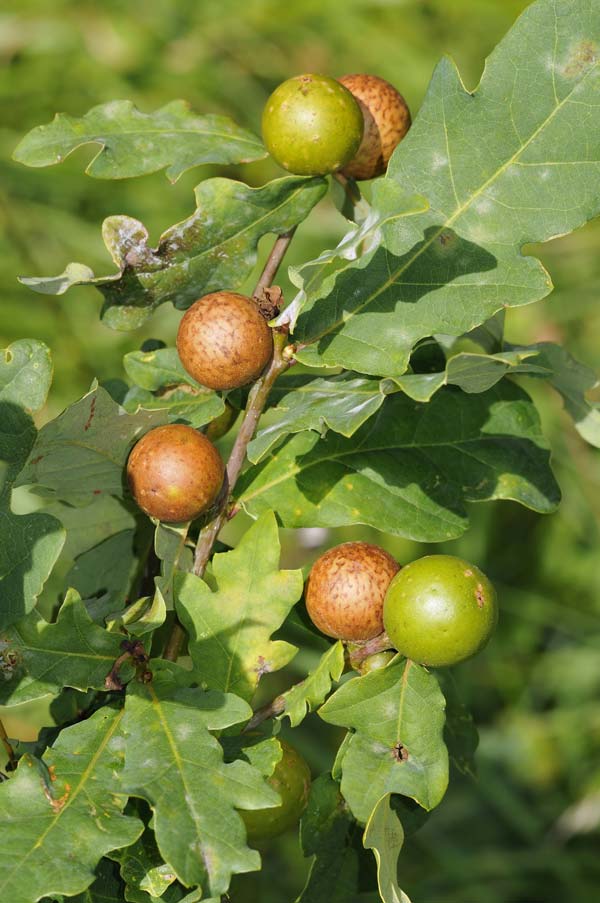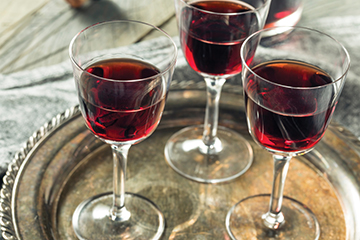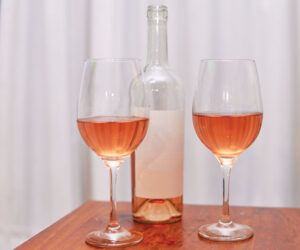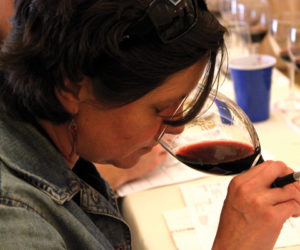Q I hear a lot of winemakers talk about “sacrificial” tannins. What the heck is sacrificed with tannins added early?
Larry Roux
Syracuse, New York

A Tannins, or the compounds in grapes (and oak barrels) that contribute to a pleasing sensation of astringency in red (and some white) wines, are found in grape skins and seeds. As a class of compounds, they are very important in winemaking as they are amazingly powerful antioxidants in addition to contributing in important ways to the sensorial quality of any given wine. A very tannic wine can make your mouth, tongue, and cheeks feel puckery and dry but a wine that has a balanced tannin level will have some “grip” while not being overpoweringly tannic. Big red wines like Petite Sirah and Cabernet Sauvignon will normally contain more tannins than lighter reds like Pinot Noir; the grape skin chemistry is just that different. As a result, Pinot Noirs generally feel softer on the palate but, due to their lower tannin content, might not age as long or as well as a more tannic red wine counterpart.
Proper tannin management during the winemaking process, from grape to bottle, is a skill set that can take years for winemakers to master because each variety, region, vineyard, and vintage is different. The natural tannin levels in any given red fermentation can vary greatly from one to the other. In addition to agitating the skins via punchdowns or pumpovers during the fermentation process (called “maceration”) to extract tannins, winemakers can also add tannins at many points along the winemaking timeline. These tannins can be in liquid or powder form and are sourced from grape skins, grape seeds, oak wood, oak galls, and even quebracho wood (a South American tree). In addition, aging in oak barrels or using oak pieces or staves during aging are also technically a tannin addition as tannins present in the wood will get leached into the wine over time.
Intuitively, the closer a wine is to being bottled (and therefore then left to age and mellow on its own), the more careful a winemaker should be about making drastic tannin additions. Also, as my loyal readers know, I always recommend bench trials when making additions lest we go too crazy and make an addition we don’t like.
That being said, the safest and arguably best time to boost a wine’s tannin content is early on in the winemaking process, as they’ll have the most time to integrate into a wine and become a seamless supporting addition to the entire wine matrix. The term “sacrificial tannins” that you are asking about, are tannins added especially early on in the winemaking process, usually upon crushing or very soon thereafter. The idea is to add these tannins to must so that they will be oxidized early on in the winemaking process, instead of the grape skin tannins that you want to keep.
So, what gets “sacrificed” by adding sacrificial tannins? Many of the added tannins themselves. By adding extra tannin at the beginning and increasing the overall tannin content in any given fermentation, both grape tannins and the added tannins will be oxidized, or sacrificed. By adding extra tannins into the mix, a greater proportion of grape skin tannins will be preserved than if you didn’t add any extra tannin. Many winemakers also feel that by adding tannins at crushing (which act as an oxygen sink) they can get away with adding less sulfur dioxide at crushing as well.
There are many different types of tannin on the market from just about every major winemaking supplier. Most are classed as “fermentation tannins,” “aging tannins,” and “finishing tannins.” Finishing tannins are intended for use within 3–6 months prior to bottling, aging tannins are supposed to be added after all fermentations are complete, and, as you may presume, fermentation tannins are meant to be added during active fermentation.
Anecdotally, I’ve found that finishing tannins are gentler, more refined, and often more expensive as they tend to be aromatic oak extracts. One can add them usually up to 6 weeks before bottling because the effect is subtle, and the molecules are smaller and “marry” with the wine much more easily than the rougher aging and fermentation tannins. I wouldn’t waste my money by putting finishing tannins into a fermentation where they may just drop out of solution over time and not “stick” in the final wine after the tumult of the fermentation, racking, and aging process. It’s critical to always do very careful bench trials when adding anything that close to bottling.
I find that aging tannins as a class can be quite angular and, depending on the brand, can be quite rough and aggressive. It’s important to do bench trials here as well, lest you add too much of something unpleasant. Fermentation tannins (or sacrificial tannins) tend to be the simplest and the least expensive and are often the roughest tasting. They really should be used only for fermentation. Even then, I would still tend to hew to the lower range of the manufacturer’s suggested addition rate, just to be safe.
Another more nuanced way to introduce tannins into a fermentation, and a method I often employ, is to add a 50/50 mixture of toasted and untoasted fine-grain oak chips to the fermentation at the rate of about 1–1.5 g/L. My favorite brand is Radoux (they have a great mixed product called “Duofresh”) and I find that it helps preserve color, serves as an oxygen sink, and also starts the wine along its way to gain in subtle oak character. The quality of the oak is very high; these aren’t “shop floor shavings” at all. Other oak producers sell similar products — they are worth seeking out as I find them to be subtler and a little more forgiving than adding straight up tannin powders or liquids to fermentations.
Q Could you please clarify for me once and for all, does distilled water have a place in yeast rehydration? I have found conflicting information on this from various winemaking resources.
Mario Sarra
VIA EMAIL
A Rehydrating dried yeast is a simple and straightforward process, and one that I find to be essential when using dried yeast for winemaking purposes.
The simple answer to your question is no, do not use distilled water for yeast rehydration. Distilled water is not osmotically balanced, which means that it can actually disrupt the delicate cellular membranes of your developing yeast. Distilled water is just that — distilled. That means that water (could be tap, or from any other source) has been boiled and the resulting steam condensed back into liquid form, leaving any salts, minerals, or other dissolved solids behind. As such, the water is too clean (free of anything except molecules of hydrogen and oxygen) and since physics dictates that solutes move from an area of high concentration to low concentration, distilled water will essentially push into the cell membrane until some yeast cells burst during the rehydration process or weaken the cellular membrane. The end result could be a loss of viability in your culture, which is the exact opposite of what you want when adding yeast to a fermentation. Less than fully viable yeast increases the chances of sluggish, stuck, or otherwise compromised fermentation, which can lead to not only sweet wine (stuck fermentation) but also a whole host of other wine flaws like increased VA (volatile acidity), acetaldehyde, or ethyl acetate production (smells like oxidized apples and nail polish remover, respectively).
While it might be tempting to use distilled water because it doesn’t contain any chlorine (which can cause TCA or “corked” defects) and if in a closed container is sterile, it may actually be better to use bottled mineral water or even your own home’s tap water, as long as it doesn’t contain any chlorine. If you suspect your water has chlorine, it’s easy to buy faucet-mounted filters from any hardware store or online. Metabisulfite can also be utilized to knock chlorine out of water. If you’re worried about your water containing microbes (i.e., it’s not sterile) you can always boil and then cool your rehydration water before using it.
No matter which water you use, always follow the rehydration protocol for your yeast strain of choice. Most suppliers have directions on their website, if not on the actual packaging. I also like to use a rehydration nutrient, which helps the awakened yeast cells get off to their best start, no matter what the must or juice conditions. An example is Go-Ferm (a Lallemand product sold in the U.S. via Scott Labs). A small amount of the nutrient is dissolved in the warm water you’ll use for hydration. So you can use distilled water if the nutrients are added prior to the yeast. Again, it’s important to follow the manufacturer’s instructions.
Here are some handy conversions for everyone to note (save them somewhere, because you’ll always use them no matter what part of winemaking you’re doing). The internet is also full of handy automatic calculators, but it’s always faster to have some of these memorized so all you have to do is plug them into a calculator and don’t have to be bothered to search online.
1 hL= 100 L
1 L = 1,000 mL = 0.264 U.S. liquid gallon
1 U.S. liquid gallon = 3.785 L = 3,785 mL
1 kg = 1000 g = 2.2 lbs.
1 lb. = 0.454 kg = 454 g
These conversions can make reading between different suppliers and products a little easier. Happy re-hydrating!
Q Why do you need to add potassium sorbate to blackberry Port after back-sweetening when you are adding brandy to prevent refermentation? A recipe I have for blackberry Port calls for potassium sorbate at the end and then the sugar at a rate of 3 lbs. per gallon of wine (355 g/L) then a pint of brandy per gallon (125 mL/L). I have made this five times without using potassium sorbate the first three times. The fourth time I had some refermentation and corks went flying. Maybe I didn’t have enough brandy. But why is the sorbate needed if enough brandy is added?
Jerry Black
Portland, Maine

A Well, in the olden days of fortified winemaking, potassium sorbate (a potassium salt of sorbic acid) wasn’t even a thing. While sorbic acid does occur naturally in some plants (rowan berries and hippophae berries, to be exact), almost all of the world’s potassium sorbate is made in a laboratory. In addition to potassium sorbate being a relatively modern, artificial ingredient, I also object to the aroma and taste of it in wine, which gives me fake pineapple and geranium vibes. Not so great. Luckily, there are some things you can do to ensure you get a completely arrested fermentation (and no re-fermentation) the next time you attempt your blackberry Port.
When making fortified wines, a must or juice is usually started just like normal, and then high-proof alcohol (like brandy) is gradually added in order to stop the fermentation. To make sure your wine gets really and truly “stuck,” I suggest employing these traditional basics: Fermentation kinetics management, temperature control, alcohol additions, sulfur dioxide additions, sugar additions, and, eventually at the end, filtration. (Note that these are the steps to producing a more traditional Port wine where little to no sugar is added to backsweeten, rather fermentation is halted in order to leave residual sugar from the original must/juice.)
• Non-robust fermentation: Under-pitch your yeast addition rate so that you don’t have a run-away fermentation that’s hard to arrest. Similarly, don’t over-feed your fermentation with yeast nutrients at the normal dry-wine level, since some of it will not be consumed when you add your alcohol to arrest the fermentation. Both of the above will help keep your fermentation moderate and easier to stop.
• Temperature control: By keeping your temperatures modest, you help ensure the fermentation won’t take off so quickly and, as such, will be easier to control and to stop when you do eventually add the alcohol. Ferment closer to the lower recommended temperature for your given strain.
• Alcohol addition: Indeed, the higher the alcohol, the less chance you’ll have of a refermentation. Most Port-style wines are over 18% alcohol, and to be safe, I’d aim for above 20% if your grape and wine style can handle the “heat.” You can fortify with a wide variety of spirits — because you’re not making your product to be sold commercially you have a lot of leeway. The traditional Port-style wine addition is brandy or grape spirits, often aged in oak. This remains a good choice but don’t turn down fruit-flavored spirits, unoaked spirits like grappa, or even a little Bourbon, if you’re hankering to make a Bourbon-barrel-aged type final product. No matter which spirit you use, be sure to do the algebra correctly . . . and don’t forget that “proof” is twice the alcohol content, i.e., an 80-proof spirit is 40% alcohol by volume.
• Sulfur dioxide addition: Yeast is sensitive (but not as sensitive as bacteria) to sulfur dioxide, so make sure a fortified wine has enough SO2. While it won’t kill yeast, it will inhibit them to a certain extent. Aim for bottling with free SO2 between 28–35 ppm for a reasonable balance between sensory quality (it won’t be too strong) and microbial abeyance.
• Optional “finishing sugar” addition: If the flavor profile of the wine and the wine’s balance warrants it, more sugar (in the form of table sugar, grape concentrate, etc.) can be added. The additional increase in osmotic pressure will further help retard yeast and bacteria growth.
• Optional filtration: Once the fermentation is stopped you will want to press, settle, and rack like normal. Be sure you keep measuring your Brix with a hydrometer (not a refractometer because the alcohol and any carbon dioxide bubbles will interfere) to make sure you’ve really stopped it. Once the wine is racked and has settled, sterile filtration is always a great technique to employ to make sure all microbes are excluded.
At the end of the day, if you really want to use potassium sorbate, you can add it at the rate of ½ teaspoon per gallon (3.8 L) of wine.







